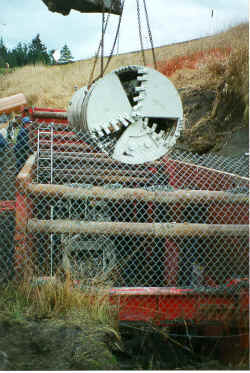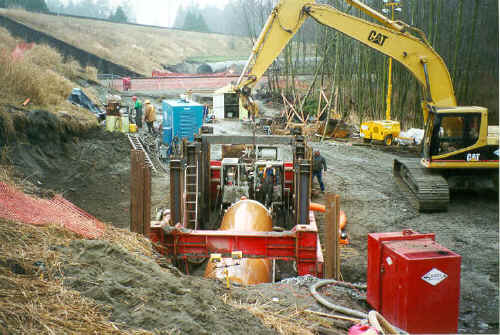| SURREY PIPE JACK |  |
|
|
| A general view of the Highway 10 Crossing and the Jacking Pit with the Permalock pipe |
|
The Greater Vancouver Regional District is expanding a sewer line in Surrey, British Columbia, which involves two trenchless crossings, one under a single set of railroad tracks and one under a four-lane highway. There are three 1680 mm
O.D., 10 mm walled steel pipes parallel to each other and about 1.6 m apart in each crossing. The railroad crossing is approximately 37 m long while the highway crossing is about 110 m long. The crossing under the railroad was completed in December 1999. Installation of the pipes under Highway 10 is presently in progress. The first two crossings under the highway have already been installed. The third is anticipated to be completed in early February. Cusano Contracting (Pacific Underground Ltd.) is the contractor and EBA Engineering Consultants Ltd. are the owners consultants. The crossings are being installed by pipe jacking using the Akkerman 5000 tunnel boring machine (TBM). The machine bores through the soil while the pipe is pushed or jacked behind it. Alignment is maintained via a laser set up at the back of the jacking pit. A target is set on the cutting face and the machine is steered such that the laser hits the target. The machine is steered hydraulically by an operator inside the TBM. Soil is removed from the face via a conveyor that feeds into a bucket. The bucket is driven by an operator along rails installed inside the pipe. The bucket is lifted out of the pit by an excavator, dumped and put back in the pit. The machine sits on a set of rails which back against the rear wall of the pit. The cutting face on the machine creates an overcut of approximately 30 mm on diameter. The pipes are manufactured in U.S.A. by Permalock Corporation. Permalock pipes were selected by the Contractor because their bell and spigot joints fit watertight without welding. Use of the pipes help to reduce the time and effort normally required for welded joints. The pipes are supplied in 10 and 20 ft. sections. Silicone sealant is put at each joint before the joint is fully closed. In order to jack the pipe, a steel ring fitting into the Permalok joint is required. To allow for annulus grouting and lubrication, ports were built into the pipes. There are normally two ports per each 20 foot section at the 10 and 2 o'clock positions. Some pipes have a single port at the crown. Installation under the railroad was mostly through peat and silt. No lubricant was used. Installation of the first pipe was initially attempted using an open-face cutting head; however, sand fill just at the crown of the pipe made it necessary to switch to closed-face. Upon completion of jacking, the outside of each pipe was grouted with foamcrete to close any voids due to the overcut of the machine. This method did not cause any disruption to train traffic during installation and there was negligible settlement of the ground surface. Installation under the highway was predominantly through hogfuel, for which there was no existing information on behaviour during jacking. High skin friction was anticipated and, accordingly, high jacking forces. For the first pipe under the highway an intermediate jacking station was installed halfway through the drive. Bentonite lubricant was used continuously for most of the pipe. The lubricant was pumped through a port located at the crown of the pipe immediately behind the TBM.  The jacking loads were measured at every 0.3m interval. Upon completion of the project valuable data on jacking friction along the pipe for the type of soft/firm soil typical of the Vancouver's lower
mainland and also between hog fuel and the pipe will be available for the first time. The jacking loads were measured at every 0.3m interval. Upon completion of the project valuable data on jacking friction along the pipe for the type of soft/firm soil typical of the Vancouver's lower
mainland and also between hog fuel and the pipe will be available for the first time.A number of road embankments in the lower mainland are made of the hogfuel. The data will be of much use in planning future jacking projects through soft soil and hogfuel. Naresh Koirala - EBA Engineering Consultants Ltd., Vancouver, B.C. Paul Wilting - Greater Vancouver Regional , GVRD |
|
A general view of the Highway 10 Crossing |
